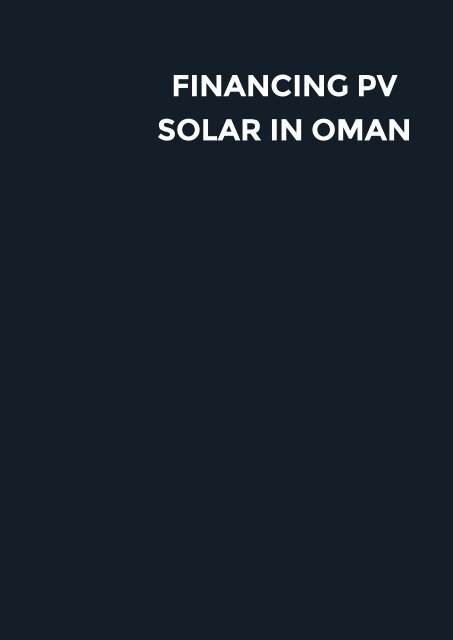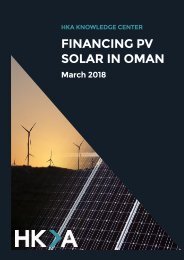You also want an ePaper? Increase the reach of your titles
YUMPU automatically turns print PDFs into web optimized ePapers that Google loves.
FINANCING PV<br />
SOLAR IN OMAN
FINANCING PV S<br />
Conscious of the finite life of its natural energy resources and its increasing demand<br />
for energy, <strong>Oman</strong> has recently announced two major Solar PV projects to the<br />
market. Through the projects, <strong>Oman</strong> is seeking to leverage it strong track record in<br />
the IPP market and attract third party capital to meet its long term energy needs.<br />
However, in light of the challenges currently facing the <strong>Oman</strong>i market, private<br />
sector participants will have to carefully consider how this substantial level of<br />
investments ($600 million+) can be raised.<br />
The following general <strong>Oman</strong> economic risks are likely to impact the availability and pricing of finance to support<br />
the Project<br />
Downgrade to <strong>Oman</strong>i<br />
Credit Rating<br />
Stability of the <strong>Oman</strong>i<br />
banking sector<br />
Reduced<br />
funding<br />
appetite<br />
Shorter<br />
tenors<br />
Increased<br />
pricing<br />
Increase in <strong>Oman</strong>i<br />
public sector debt<br />
Lower hold<br />
levels<br />
Additional<br />
guarantees<br />
Reliance on<br />
local market<br />
<strong>Oman</strong> political risk<br />
Downgrade to the <strong>Oman</strong>i Credit Rating<br />
Although historically investment grade, <strong>Oman</strong>’s credit<br />
rating has been subject to a series of downgrades since<br />
2015. The currently rating of BB (S&P) and Baa3 (Moody’s)<br />
creates a challenging funding environment—particularly<br />
for international funders.<br />
Stability of the <strong>Oman</strong>i banking sector<br />
<strong>Oman</strong>’s banking sector is traditionally heavily reliant on<br />
government deposits. After a period of sustained<br />
pressure, during which the government successfully<br />
raised $5 billion of much needed funds through a March<br />
2017 bond issuance, liquidity pressures on the banks look<br />
likely to ease. In addition, the improvement in the oil price,<br />
the fiscal reforms and a relatively well capitalized financial<br />
sector have all led to a fairly stable banking sector.<br />
Increase in <strong>Oman</strong>i public sector debt<br />
<strong>Oman</strong>’s public debt has risen from 5% of GDP in 2014 to a<br />
projected 50% by 2020. This level of increasing debt is<br />
unsustainable in the long term and makes the economy<br />
particularly vulnerable to any further interest rate rises. A<br />
$5 billion bond issuance was required last year to restore<br />
liquidity to the domestic market and the need for external<br />
financing may continue and potentially lead to a downward<br />
debt spiral if unfavorable economic conditions persist.<br />
<strong>Oman</strong> political risk<br />
Although within the in the region <strong>Oman</strong> is viewed as a<br />
relatively stable political regime with relatively low political<br />
risk, international investment still view with caution the<br />
overall stability of the Middle East
OLAR IN OMAN<br />
MEETING THE FUNDING CHALLENGE<br />
In light of the challenges poised, developers seeking to raise capital will need to blend together a final funding<br />
package from a range of sources:<br />
Export<br />
Credit<br />
Agencies<br />
International<br />
funders<br />
Regional<br />
funders<br />
Relationship<br />
funders<br />
Equipment<br />
suppliers<br />
Blended funding package<br />
ECA solution<br />
Projects of this nature lend themselves to an ECA-backed funding<br />
solution. Most <strong>Oman</strong> IPP projects have some form of ECA support<br />
within their funding structures. However, in light of the credit downgrade,<br />
the use of an ECA may be a pre-requisite.<br />
Likely credit appetite:<br />
✓ ✓ ✓ ✓<br />
International funders<br />
The credit downgrade is likely to limit international funders’ appetite<br />
to support the Projects – particularly if the potential implications of<br />
the move to the BOOT structure are not supported by a suitable<br />
Government/credit guarantee.<br />
Likely credit appetite:<br />
✓ ✓<br />
Regional funders<br />
Local funders have been active in the funding of previous IPP structures<br />
and can therefore be viewed as potentially a key source of<br />
finance. However, prior to such an inclusion, shareholders will need<br />
to understand:<br />
• The ability to act within a funding club which potentially does<br />
not include an international funder<br />
• The speed at which a local funder can operate<br />
• Local appetite for <strong>solar</strong> technology (noting although technology<br />
risk is likely to be low, these are the first significant<br />
PV <strong>solar</strong> projects in <strong>Oman</strong><br />
Likely credit appetite:<br />
✓ ✓ ✓ ✓<br />
Relationship funders<br />
The Consortium Sponsor’s primary funders (either at a corporate or<br />
project level). These funders may be either international or local.<br />
Likely credit appetite:<br />
✓ ✓ ✓ ✓<br />
Equipment suppliers<br />
The supplier of the PV Solar panels may look to provide a form of<br />
asset-based lease finance.<br />
Likely credit appetite:<br />
✓ ✓ ✓ ✓<br />
The implications of a Build-Own-<br />
Operate—Transfer contracting model<br />
It appears the Projects are to be procured under a BOOT<br />
commercial structure, as opposed to the historically typically<br />
<strong>Oman</strong>i BOO structure. This change in risk allocation<br />
is likely to impact the commercial structure in a number<br />
of ways:<br />
• Requirement for Government guarantees -<br />
specifically in relation to the repayment of senior<br />
debt in the event of default or termination<br />
• Ability to IPO - the finite life of the projects under<br />
a BOOT structure means an IPO is unlike to be attractive<br />
to the market<br />
• No post PPA value - The transfer of the asset at<br />
the end of the PPA effectively prevents shareholders<br />
from realising any post-PPA value.
OUR TEAM<br />
HKA continues Hill International’s legacy, built up over 40 years working across<br />
the Middle East and Africa. With the same staff, technical skills and experience,<br />
HKA continues to provide the highest level of client satisfaction and excellence.<br />
Stephen Watson is a project finance and infrastructure specialist with 22 years’ experience of advising governments<br />
and private sector developers within the Infrastructure & PPP markets across the UK, Europe,<br />
1976<br />
Irvin E. Richter launches Hill International, Inc. from his home in<br />
Willingboro, New Jersey, USA.<br />
2006<br />
2007<br />
2010<br />
2013<br />
2014<br />
2017<br />
2017



